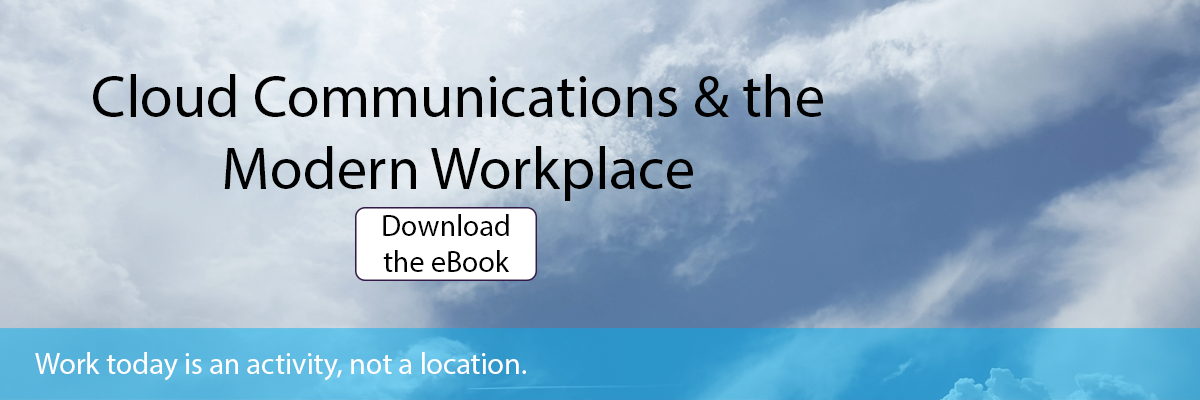Customers today are inundated with opinions about what technology is best for their business and also how they should purchase that technology. All businesses are different, and so it is important to consider what they need for communications tools and what makes the most sense from a financial aspect.
An excellent place to start is understanding the difference between the two fundamental ways of delivering communications systems today; Hosted/Cloud versus Premise Based.
Hosted/Cloud solutions provide customers with robust solutions at a monthly cost.
The upsides of a hosted/cloud are usually viewed as being low-maintenance platforms that are all-inclusive when it comes to the monthly cost. These types of solutions tend to come with phone hardware and software along with dial tone and usage under one bill. Many IT professionals and system administrators like the idea of a “rented” technology because it's viewed as easier to upgrade at the end of the rental term. The monthly budget is already there so moving to a new or upgraded technology is seen as easier through this model.
From a financial aspect, the Hosted/Cloud has upsides as well.
The thought of a fixed monthly cost with no capital expenditure is very attractive to some CFOs. Factors such as annual maintenance costs, personnel costs, depreciation and even the current value of money are all things taken into consideration by financial leaders of organizations. This is why it is important to not only understand what your business may need to make it run at an optimal level but also how you want to own that solution. For example, not all schools and municipalities can purchase things in a “monthly rental” format. The nature of their budget process may dictate that a more traditional capital expenditure purchase takes place.
The more traditional way of procuring a communications platform is the Premise Based system.
This entails the outright purchase of a hardware/software system and installing it on a physical site. There is usually a onetime fee for the equipment and implementation with only a monthly fee for carrier dial tone. After the warranty period, these solutions also can carry an aftermarket warranty and extended software support option. With these solutions varying in sophistication and size, it becomes more important to purchase the right one from an investment protection aspect. Pick the wrong one and your business can find themselves in the market for new technology before they planned to. You need to decide what the expectation is for the lifespan of the communication solution.
Conventionally the premise-based system can be more functional and flexible than the hosted solution, however, there is a growing trend with hosted offerings to provide application plug-ins with other systems that may not be available easily to premise-based systems. There is much more flexibility to cater to the individual needs of the end user and with today’s programming interfaces, it is much easier to accomplish. By nature, these types of solutions are generally designed and expected to be a longer-term investment for your company.
In most cases, the software running these systems is upgradable so obsolescence is less of an issue than ever before. The selection of what is best is unique to your specific needs. Trusted experts in this area are important to consult with and help guide you through the important elements to consider.
There are many financial aspects to consider when looking at the premised based system.
While you may not have the financial flexibility of not tying yourself to a longer-term solution, as a general rule the capital purchase may appear to be the cheapest way to own a communications solution. In reality, there are many factors such as ongoing maintenance, depreciation of equipment, carrier costs, and system administration costs to consider. Companies need to understand the total cost of ownership of either solution type and what fits the organization goals, to make the best decision.
Four considerations drive the purchasing decision from the CFO’s perspective:
Cost, value, cash, and risk. Offering a specified product at the lowest price is presumed to be the most attractive and is, therefore, usually awarded the contract. This is especially true of governmental agencies or entities purchasing with government sourced funding and is a good solution for the need. Sometimes, however, the bid request does not envision a better solution. The discussion above compares the flexibility of premise versus hosted solutions and the needs of the buyer are likely to differ sufficiently to drive the decision. The value judgment here is which solution offered, genuinely fills the need better, a consideration where the cost is now secondary.
Finance is always looking at the entity’s greater cash needs as part of this decision. Budgeting for a monthly lease payment has been viewed as more attractive because of its lower perceived cash requirements. However, the low-interest rates in effect for several years now, coupled with the federal tax reform enacted in December 2017, reduce the cost of borrowing for capital acquisitions and allow for full first-year depreciation. These factors have now made this, effectively, a toss-up.
Financial decision makers always make risk-averse decisions because they are weighing the potential cost of risks. Hence, they favor clear policies, proactive training, insurance and other safeguards that mitigate risks. So, what is the risk if the phones don’t work, or the network isn’t accessible or worse, is attacked? The CFO will likely be heavily influenced by the solution that best preserves critical function and infrastructure while providing the best value and the most attractive cost.
What makes sense for your organization is best determined by you and your accountants. This information is meant as a general guideline and is not intended to be professional accounting advice specific to any organization.
Originally published on 08/27/2018







